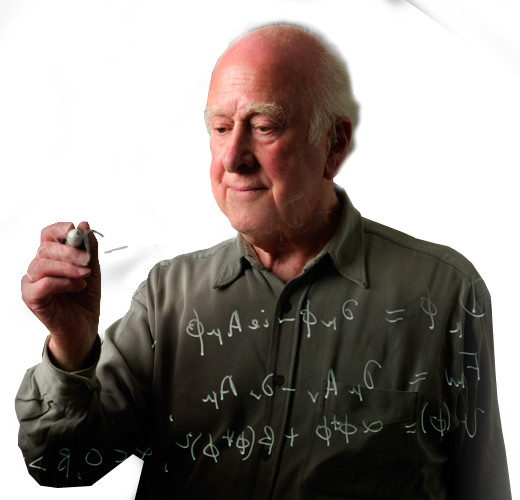Prince of Asturias Award for Technical & Scientific Research 2013

Petter Higgs

Petter Higgs Biography
Peter Higgs (Newcastle upon Tyne, UK, 20th may 1929) studied physics at King's College, University of London, where he earned his PhD in 1954. That same year, he moved to the University of Edinburgh, where he began his teaching and research work and where he was to spend his entire career, except for a hiatus of four years in London.
He was promoted to the Chair of Theoretical Physics in 1980 and became Professor Emeritus at the University of Edinburgh in 1996. Broken Symmetries, Massless Particles and Gauge Fields, published in September 1964 in Physics Letters, and Broken Symmetries and the Masses of Gauge Bosons , published a month later in Physical Review Letters, are the articles in which Higgs presented his theory regarding the existence of the scalar boson.

Petter Higgs Recognitions
Fellow of both the Royal Society of Edinburgh and the Royal Society of London, Honorary Fellow of the Royal Scottish Society of Arts and Honorary Member of the Saltire Society, Peter Higgs has been awarded honorary degrees by the Universities of Bristol, Edinburgh, Glasgow, Swansea, Cambridge, Heriot-Watt and King's College London and by University College London.
Higgs has received numerous awards for his contributions to Physics, including the High Energy and Particle Physics Prize, which in 1997 the European Physical Society conferred on him, together with Brout and Englert; the Wolf Prize in Physics, shared with Brout and Englert (Israel, 2004); the Sakurai Prize from the American Physical Society, shared with Brout, Englert, Guralnik, Hagen and Kibble (2010); the Nonino Prize (Italy, 2013); and, jointly with CERN, the Edinburgh Medal at the Scottish capital's International Science Festival (2013).
Petter Higgs Prince Of
Asturias
Aword
At its meeting in Oviedo, the Jury for the 2013 Prince of Asturias Award for Technical and Scientific Research, made up of Mr Juan Luis Arsuaga Ferreras, Mr Juan Ignacio Cirac Sasturáin, Mr Luis Fernández-Vega Sanz, Ms Cristina Garmendia Mendizábal, Ms María del Rosario Heras Celemín, Mr Bernardo Hernández González, Mr Emilio Lora-Tamayo D'ocón, Mr José Antonio Martínez Álvarez, Mr Amador Menéndez Velázquez, Ms María Teresa Miras Portugal, Mr Ginés Morata Pérez, Mr Enrique Moreno González, Mr César Nombela Cano, Mr Eduardo Punset Casals, Ms Marta Sanz-Solé, Mr Manuel Toharia Cortés, chaired by Mr Pedro Miguel Echenique Landiríbar and with Mr Vicente Gotor Santamaría acting as secretary, have unanimously decided to bestow the 2013 Prince of Asturias Award for Technical and Scientific Research jointly on physicists Peter Higgs (UK) and François Englert (Belgium) and the international institution CERN, the European Laboratory of Particle Physics, for the theoretical prediction and experimental detection of the Higgs boson.
In 1964, the pioneering work of Higgs and of Englert and Brout (the latter died in 2011) established the theoretical basis for the existence of the so-called Higgs boson. This particle completes the Standard Model, which describes the fundamental components of Nature, and is responsible for certain elementary particles possessing mass. For nearly half a century, efforts to find the Higgs boson were unsuccessful due to the enormous experimental difficulties associated with its precise and unequivocal detection. The Higgs boson was finally identified in 2012 by the ATLAS and CMS detectors of the LHC particle accelerator at CERN, a milestone for the entire scientific community.
The discovery of the Higgs boson is a prime example of how Europe has led a collective effort to solve one of the deepest mysteries of physics.
Oviedo, 29th May 2013